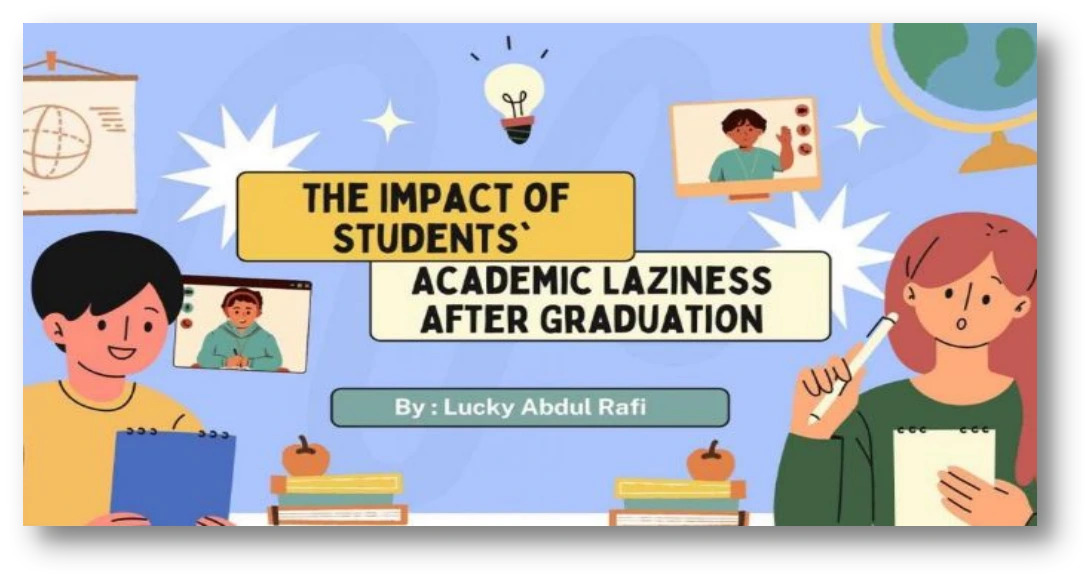Introduction
The cornerstone for developing high-quality human resources is education.
In addition to acquiring knowledge and skills, education helps people grow in morality, character, and the desire to give back to society.
Laziness, however, is one of the many difficulties and roadblocks that frequently appear during the process.
Being lazy, which may be defined as having a reluctant attitude or putting off work without a good cause, has become a major issue in the field of education.
In the educational context, being lazy has a significant impact on the learning process overall in addition to a student’s academic performance.
Over time, indolence can lower educational standards and produce a generation that is less capable.
The impact of laziness on education, its contributing reasons, and the tactical measures that can be used to combat it must thus be thoroughly examine.
Baca juga: The Relationship between Student& Academic Achievement and Healthy Sleep Patterns
Causes of a Lack of Motivation Not Clearly
Defined Learning Objectives
While learning objectives are unclear, students find it difficult to comprehend the relevance and purpose of the content being taught.
For example, students may perceive math as abstract and unrelated to their everyday lives if a teacher merely says, “We’re learning math today,” without elaborating on how the topic is used in everyday situations like travel planning, discount calculations, or money budgeting.
Because they are unable to recognize the usefulness of what they are learning, they consequently lose interest and motivation.
Students who have vague goals are also less likely to be invested in and take effort in the process of education because they lack a specific goal or objective to work toward.
Methods and Approaches to Combating Educational
Laziness, a multimodal strategy that addresses the underlying causes of disengagement in addition to behavior modification is necessary to overcome laziness in education.
Increasing self-awareness and personal drive is one of the best strategies to combat academic laziness.
Many pupils don’t fully get the purpose of the lessons they are taking.
Education can seem like a collection of pointless assignments forced upon them if they lack a sense of purpose or direction.
At this point, direction becomes crucial.
Innovation in Learning Methods
In the modern digital era like today, traditional learning methods that only focus on one- way lectures are no longer effective for most students.
They need a more varied, fun, and relevant approach to their daily lives.
Therefore, teachers are required to be more creative and innovative in delivering materials so that learning becomes more interesting, interactive, and meaningful.
Using Digital Media, the use of technology in learning is no longer an option, but a necessity.
Digital media such as learning videos, interactive presentations, simulations, animations, and educational applications can help students understand abstract concepts in a more concrete and visual way.
In addition, learning platforms such as Google Classroom, Canva, Quizizz, Kahoot! and others can be used to increase student engagement actively and enjoyably Parents and the surrounding environment hold a crucial role in ensuring a child’s educational success.
While schools serve as the primary setting for formal learning, a well-rounded education cannot be fully achieved without the support and positive influence from the home and community.
Students today are used to dynamic forms of interaction, quick access to information, and multimedia content.
Teachers are therefore urged to adopt a variety of teaching techniques that integrate visual aids, group projects, with experiential learning in place of the traditional chalk-and-talk approach.
Lessons ought to be created with curiosity, creativity, and critical thinking in mind.
Students take an active role in their educational journey as a result, which increases motivation and retention.
Active Parental Involvement in Their Kids’ Education
Parents play an equally vital part in a child’s academic performance as do educators and educational institutions.
Education must be viewed as a joint endeavor between the family and the school, not just the school’s responsibility.
Children who have their parents actively involved are more likely to be motivated, do well in school, and grow up with a greater sense of responsibility.
Active parental involvement fosters the child’s intellectual and personal development by providing emotional, intellectual, and communication support.
Baca juga: Unique Innovation of UHAMKA Economic Education Students in Creative Economy Class
Encouragement of Home Learning
At home, parents should support youngsters with their studies by leading them through the procedure, assisting them in understanding ideas, and making sure they stay on track with assignments—not by doing the task for them.
As an illustration, if a youngster is having trouble with their arithmetic assignment, the parent can sit down with them and break down the challenges, explaining each step in detail, rather than giving them the solutions.
Furthermore, creating a peaceful, distraction-free study space at home can have a big impact on focus and output.
Conclusion
All parties involved—students, instructors, parents, and legislators—must take the critical problem of laziness in education very seriously.
It affects not just the individual but also the general well-being of subsequent generations.
Collaboration is therefore crucial to creating a system of education that can boost motivation, foster a strong academic culture, and ignite a passion for learning.
favorable academic results.
It’s not easy to overcome lethargy, but with the correct tactics, character-building, high-quality education is achievable.
Data and Facts on Unemployment and Poverty in Indonesia
As of February 2024, the Central Statistics Office (BPS) reported that the open rate of unemployment (TPT) was 5.32%, or around 7.2 million people.
Most of them are recent secondary school and vocational college grads who lack competitiveness and other abilities.
As of March 2024, around 25.5 million people, or 9.36% of the country’s total population, lived in poverty in Indonesia.
Low levels of education and insufficient skills are major causes of poverty because they make it hard for people to find respectable jobs and make enough money.
A report from the World Bank also highlights that poor-quality education—particularly the lack of 21st-century.
Digital literacy, problem-solving abilities, and critical thinking are among the talents that contribute significantly to the high percentage of underemployment, in which people find employment but not to achieve their full potential.
The Need for Collaboration to Combat Laziness and Improve the Quality of Education.
As a result, collaboration across all domains is essential to creating an educational system that can: Spark students’ passion for learning through creative and significant methods.
Promote intrinsic motivation in pupils so they study for real interest and purpose rather than just grades or tests.
Encourage a supportive learning environment that highlights the value of hard work, curiosity, and the actual learning process.
Baca juga: Does A Graduate Student from Education Program Have To Be A Teacher?
To make sure students are ready to enter the labor market or explore entrepreneurship, education should also emphasize character development, real-world life skills, including vocational training.
Penulis: Lucky Abdul Rafi
Mahasiswa Jurusan Arabic Language Education, Universitas Muhammadiyah Prof. Dr. Hamka
Editor: Anita Said
Bahasa: Rahmat Al Kafi
Ikuti berita terbaru Media Mahasiswa Indonesia di Google News















